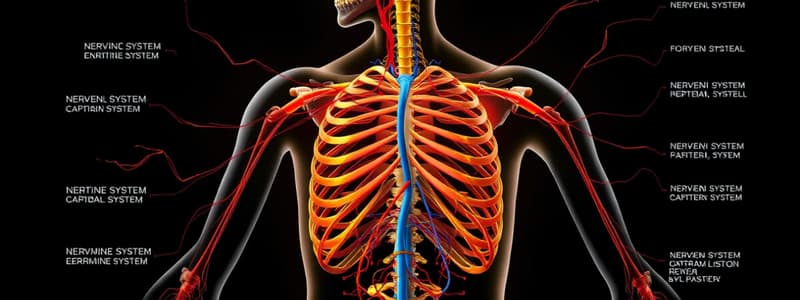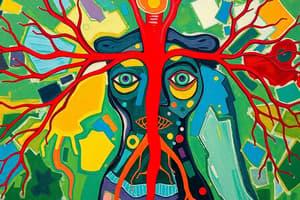Podcast
Questions and Answers
What is the primary difference between the nervous system and the endocrine system in terms of response time?
What is the primary difference between the nervous system and the endocrine system in terms of response time?
- Both systems provide responses at the same speed.
- The endocrine system provides a faster response than the nervous system.
- The nervous system provides a rapid response, while the endocrine system is slower. (correct)
- The nervous system provides a slower response than the endocrine system.
Which part of the brainstem is mainly responsible for integrating vital autonomic reflexes?
Which part of the brainstem is mainly responsible for integrating vital autonomic reflexes?
- Midbrain
- Pons
- Medulla oblongata (correct)
- Cerebellum
How does conscious control of movements differ from subconscious reflexes?
How does conscious control of movements differ from subconscious reflexes?
- Conscious control is initiated by the spinal cord.
- Conscious control is regulated by the peripheral nervous system.
- Subconscious reflexes do not involve any nerve impulses.
- Conscious control requires coordination of more synapses for complex actions. (correct)
Which of the following parts of the brainstem is involved in respiratory control?
Which of the following parts of the brainstem is involved in respiratory control?
Which statement accurately reflects the role of the cerebral cortex in conscious control?
Which statement accurately reflects the role of the cerebral cortex in conscious control?
In which area do impulses travel during motor information processing?
In which area do impulses travel during motor information processing?
What is the role of the pons in the brainstem?
What is the role of the pons in the brainstem?
Which reflexes are primarily coordinated by the midbrain?
Which reflexes are primarily coordinated by the midbrain?
What are the two types of reflexes classified in the nervous system?
What are the two types of reflexes classified in the nervous system?
Which of the following statements about autonomic reflexes is accurate?
Which of the following statements about autonomic reflexes is accurate?
What is the primary function of the hypothalamus?
What is the primary function of the hypothalamus?
Which part of the pituitary gland is responsible for secreting hormones like ADH and oxytocin?
Which part of the pituitary gland is responsible for secreting hormones like ADH and oxytocin?
What type of communication affects nearby cells?
What type of communication affects nearby cells?
What is the functional unit of the thyroid gland responsible for hormone production?
What is the functional unit of the thyroid gland responsible for hormone production?
Which chemical class of hormones is water soluble?
Which chemical class of hormones is water soluble?
Which hormone is secreted by the parafollicular cells of the thyroid gland?
Which hormone is secreted by the parafollicular cells of the thyroid gland?
Which characteristic does NOT apply to reflex actions?
Which characteristic does NOT apply to reflex actions?
What portion of the pituitary gland secretes hormones in response to releasing and inhibiting factors?
What portion of the pituitary gland secretes hormones in response to releasing and inhibiting factors?
Study Notes
Nervous System
- Functions with rapid response through action potentials and neurotransmitters.
- Controlled consciously (cerebrum) or subconsciously (somatic/autonomic reflexes).
Endocrine System
- Functions with slower, prolonged responses using hormones transported via blood.
- Operates through feedback loops to maintain homeostasis.
Conscious Control
- Initiated in the cerebral cortex, characterized by 2-4mm of grey matter.
- Involves conscious thought and the recognition of stimuli.
Sensory Information Processing
- Involves receptors and sensory/afferent neurons transmitting to CNS.
- Integration occurs in spinal cord (ascending pathways) and brain (ascending to cerebral cortex).
Motor Information Processing
- Initiated by the cerebral cortex for conscious decision-making.
- Involves descending tracts through cerebrum, brainstem, and spinal cord to motor/efferent nerves.
Brainstem Composition
- Comprised of three parts: medulla oblongata, pons, midbrain.
- Functions as a primitive brain section with essential integration centers for vital functions and reflexes.
Medulla Oblongata
- Continuation of the spinal cord with considerable white matter and nuclei for autonomic reflexes.
- Regulates heart rate, blood vessel diameter, respiration, hiccupping, coughing, sneezing, swallowing, and vomiting.
Pons
- Acts as a bridge connecting the medulla, midbrain, and cerebellum.
- Contains nuclei controlling sleep (REM) and respiratory functions, working with the medullary rhythmicity center.
Midbrain
- Positioned between the pons and diencephalon with significant white matter.
- Important for stabilizing movement and includes reflex areas for visual and auditory responses.
Conscious vs. Subconscious Control
- Conscious control utilizes CNS for complex motor patterns like running or playing instruments; requires faster nerve impulses and many synapses.
- Subconscious control entails reflexes allowing quick, involuntary responses without higher brain involvement.
Reflexes
- Classified as somatic (control of skeletal muscles) and autonomic (control of smooth and cardiac muscles).
- Reflexes are rapid, predictable, and unlearnt, following specific neural pathways.
Hypothalamus
- Located in the diencephalon, it has an inverted triangle shape.
- Secretes factors controlling the anterior pituitary and produces ADH and oxytocin.
Pituitary Gland
- A small gland in the sella turcica, divided into anterior (glandular tissue) and posterior (neural tissue) parts.
- Anterior pituitary secretes seven hormones in response to releasing/inhibiting factors.
- Posterior pituitary secretes ADH and oxytocin via neural connections.
Endocrine System Structure
- Composed of cells that secrete hormones, either isolated or within glands.
- Differentiates between communication types: autocrine, paracrine, and endocrine.
Types of Glands
- Endocrine glands are ductless, releasing chemicals into the bloodstream.
- Exocrine glands possess ducts, secreting products like sweat and mucus.
Thyroid Gland
- Located anterior to the trachea/larynx with right/left lobes and isthmus.
- Follicular cells synthesize T3 and T4; a lack causes hypothyroidism.
- Parafollicular cells produce calcitonin, lowering blood calcium levels.
Hormone Classes
- Amino acid-based hormones: Water-soluble, include peptides and proteins, all pituitary hormones.
- Steroid-based hormones: Lipid-soluble, derived from cholesterol; characterized by names ending in –one or -ol (e.g., testosterone, estrogen).
Hormonal Transport and Function
- A hormone's chemical composition determines its transport in blood and mechanisms of action on target tissues.
Studying That Suits You
Use AI to generate personalized quizzes and flashcards to suit your learning preferences.
Description
This quiz covers the control mechanisms of the body's systems, focusing on the nervous and endocrine systems. It explores rapid responses through action potentials, neurotransmitters, and the roles of conscious and subconscious control. Understand how these systems interact, including feedback loops in hormonal regulation.




